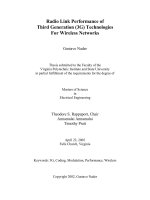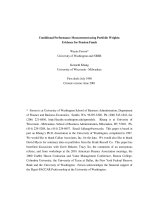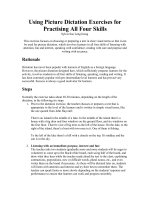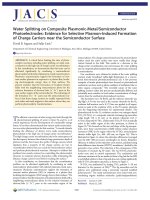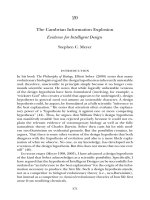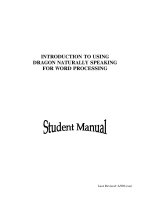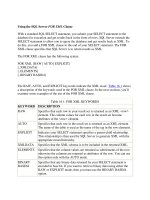Conditional Performance Measurement using Portfolio Weights: Evidence for Pension Funds
Bạn đang xem bản rút gọn của tài liệu. Xem và tải ngay bản đầy đủ của tài liệu tại đây (185.26 KB, 53 trang )
Conditional Performance Measurement using Portfolio Weights:
Evidence for Pension Funds
Wayne Ferson*
University of Washington and NBER
Kenneth Khang
University of Wisconsin - Milwaukee
First draft: July 1998
Current version: June 2001
* Ferson is at University of Washington School of Business Administration, Department
of Finance and Business Economics, Seattle, WA 98195-3200. Ph. (206) 543-1843, fax
(206) 221-6856, Khang is at Univerity of
Wisconsin - Milwaukee, School of Business Administration, Milwaukee, WI 53201. Ph.
(414) 229-5288, fax (414) 229-6957. Email: This paper is based in
part on Khang’s Ph.D. dissertation at the University of Washington, completed in 1997.
We would like to thank Callan Associates, Inc. for the data. We would also like to thank
David Myers for summary data on portfolios from the Frank Russell Co. This paper has
benefited discussions with Geert Bekaert, Tracy Xu, the comments of an anonymous
referee, and from workshops at the 2001 American Finance Association meetings, the
2000 Crabbe Huson Contrarian and Value Management Conference, Boston College,
Columbia University, the University of Texas at Dallas, the New York Federal Reserve
Bank and the University of Washington. Ferson acknowledges the financial support of
the Pigott-PACCAR Professorship at the University of Washington.
Conditional Performance Measurement using Portfolio Weights:
Evidence for Pension Funds
June 2001
Abstract
Recent studies of portfolio performance have separately introduced the use of portfolio
holdings and conditioning information. This paper combines these innovations to create
a new performance measure. Our conditional weight-based measure has several
advantages. By using conditioning information, it can avoid biases in weight-based
measures as discussed by Grinblatt and Titman (1993). When there is conditioning
information, returns-based measures (even conditional measures) also face a bias if
managers can trade between observation dates. The new measures avoid this “interim
trading bias”. We use the new measure to provide fresh insights about performance in a
sample of U.S. equity pension fund managers.
Measuring the performance of a managed portfolio has long been of interest to financial
economists and practitioners alike. However, even after years of research, several issues
remain unresolved. Among these is how to handle the dynamic behavior of a managed
portfolio. Difficulties arise, not only because the required returns on the assets in a
portfolio may be time-varying, but also because the portfolio structure may vary due to
the manager’s strategy or other influences, such as exogenous cash flows to the fund.
These dynamics create problems in measuring performance.
Most current performance measurement techniques are returns-based, and involve
regressing the return of a portfolio on some benchmark return.
The measure of
performance, or alpha, is the intercept in the regression. A strength of returns-based
methodologies is their minimal information requirements. One needs only returns on the
managed portfolio and the benchmark.
However, this ignores potentially useful
information that is often available: the composition of the managed portfolio. Cornell
(1979) was among the first to propose using portfolio weights to measure the
performance of trading strategies.
Copeland and Mayers (1982) modify Cornell’s
measure and use it to analyze Value Line rankings. Grinblatt and Titman (1993) propose
a weight-based measure of mutual fund performance.1
Previous studies that use portfolio weights combine them with unconditional
moments to measure performance. However, Ferson and Schadt (1996) put returns-based
measures into a conditional framework and find that it changes the results. Therefore, it
is interesting to consider conditioning information in weight-based measures of
performance.2
The use of portfolio weights may be especially important in a conditional setting.
When expected returns are time-varying and managers trade between return observation
dates, returns-based approaches are likely to be biased. Even conditional returns-based
1
A number of studies have used the Grinblatt and Titman measure. These include Grinblatt and Titman
(1989a), Grinblatt, Titman, and Wermers (1995), Zheng (1996), and Wermers (1997).
1
methods are affected. This bias, which we call the “interim trading bias”, can be avoided
by using portfolio weights in a conditional setting.
This paper develops a weight-based approach with conditioning information and
evaluates the relative advantages of this approach.3 We illustrate the approach on a
sample of U.S. equity pension fund managers, during 1985-1994, and document that the
growth-style pension funds tend to trade more and follow a momentum strategy,
compared with value-style funds. These differences in fund strategy allow us to highlight
several interesting features of the performance measures.
We find that a conditional weight-based measure has some important advantages.
It controls for interim trading bias in a setting where returns-based measures, including
conditional measures, are severely biased. The conditional weight measure controls for
trading on public information better than either returns-based measures or weight-based
measures that use unconditional means. Using both portfolio weights and conditioning
variables, we also obtain more precision than with the unconditional weight measure.
In our sample of pension funds, returns-based measures suggest that the funds
have positive abnormal returns, which is consistent with previous studies.4
With
conditioning information in a weight-based measure, the funds have neutral performance.
Thus, previous estimates of abnormal pension fund performance may reflect biased
measures.
2
Daniel, Grinblatt, Titman, and Wermers (1997) create characteristic-based benchmarks to measure the
performance of mutual funds, where they condition the benchmark on the fund’s characteristics.
3
Recent studies have made limited use of portfolio weights in a conditional setting, by regressing returns
on lagged weights and conditioning variables to see if the weights have marginal explanatory power [e.g.
Graham and Harvey (1996), Becker et al (1999)]. These studies are limited to market timing, and thus a
single weight in stocks versus cash. We study the weights on the full vector of assets in a portfolio. Eckbo
and Smith (1997) use a version of our measure, as developed in Khang (1997), in a study of insider trading.
4
Lakonishok, Shleifer, and Vishny (1992) found inferior performance among pension fund managers using
the S&P 500 as the performance benchmark, but Christopherson, Ferson and Glassman (1998b) show this
can be explained by the small stock exposure of the funds in their sample over a period where small stocks
perform poorly relative to the S&P 500. Coggins, Fabozzi, and Rahman (1993) find positive performance
2
The rest of the paper proceeds as follows: Section I motivates conditional weightbased measures of performance.
Section II formulates the empirical measure and
discusses its estimation. In Section III, we discuss the data. Section IV presents the
empirical results, Section V explores their robustness, and Section VI concludes the
paper.
I. The Measures
The intuition behind weight-based performance measures is rather simple.
Suppose a manager has private information telling him when returns are likely to be
higher or lower than expected by the market. Other things equal, the manager can profit
by shifting his portfolio weights toward those assets whose returns are likely to be higher
than expected and away from those assets whose returns are likely to be lower. This
suggests that the covariance between the change in a portfolio’s weights and subsequent
abnormal security returns may be used to measure performance. Here, we define a
security’s abnormal return as the component of return not expected by the market.
This paper develops the Conditional Weight Measure (CWM). The measure is
the conditional covariance between future returns and portfolio weight changes, summed
across the asset holdings. The measure can be motivated, following Grinblatt and Titman
(1993), with a single-period model where an investor maximizes the expected utility of
terminal wealth.5
among 72 equity porfolios with an unconditional returns-based approach. Christopherson, Ferson, and
Glassman (1998a) find evidence of persistent performance using a conditional returns-based approach.
5
Grinblatt and Titman (1993) point out that the covariance between the weights and subsequent abnormal
returns need not be positive for every security in a portfolio managed with private information. Consider
two securities that are correlated with each other. This manager may choose to buy one and sell the other as
a result of hedging considerations. Grinblatt and Titman (1989b) demonstrate, however, that the sum of the
covariances across securities will be positive for an investor with nonincreasing absolute risk aversion, as
defined by Rubinstein (1973).
3
A. The Conditional Weight Measure
Consider the following utility maximization problem,
{
}
~
max w E U (W0 (1 + r f ) + W0 w ’R ) | Z , S ,
(1)
~
where rf is the riskfree rate; R is the vector of risky asset returns in excess of the riskfree
rate; W0 is the initial wealth; w is the vector of portfolio weights on the risky assets; Z is
public information available at time 0; and S is private information available at time 0.
~
Private information, by definition, is correlated with R , conditional on Z. If we assume
that returns are conditionally normal and consider an investor with nonincreasing absolute
risk aversion, it follows from the optimization problem [see Khang (1997)] that
{
[
{ }] }
~
~
E w ( Z , S )’ R − E R | Z | Z > 0 ,
(2)
{
}
~
~
where w(Z,S) is the optimal weight vector and R − E R | Z are the unexpected, or
abnormal returns, from the perspective of an observer with the public information. Since
one of the variables has mean zero, equation (2) is also a conditional covariance. It says
that, conditional on the public information, the sum of the conditional covariances
between the weights of a manager with private information, S, and the abnormal returns
for the securities in a portfolio is positive.6 If the manager has no private information, S,
then the covariance is zero.
To develop the empirical conditional weight measure, we introduce a
“benchmark” weight, wb, that is in the public information set Z, so equation (2) implies
6
Since this result uses conditional normality of the returns, given (Z,S), the risk of the asset returns depends
on the precision of the signals but not on the realization of the signals. When there is private information,
S, the product of the weight and the unexpected return will be nonnormal, conditional on Z, and the
conditional covariance will depend on Z in general.
4
{
(
) }
~
E (w ( Z , S ) − wb )’ R − E (R | Z ) | Z > 0 ,
(3)
if the manager has superior information, S. Because wb is a constant given Z, it will not
affect the conditional covariance. By making wb a function of the weights of the portfolio
in a past time period, as discussed below, we use weight changes in the empirical CWM.
Weight changes are advantageous on statistical grounds, as the levels of the weights may
be nonstationary.7
B. Interpreting the Conditional Measures
Conditional performance evaluation is usually motivated by the assumption of
market efficiency with respect to the public information Z (e.g. semi-strong form
efficiency as defined by Fama (1970)). However, in practice some investors may not
monitor all public information. We argue that even an investor who does not monitor the
public information should be interested in a conditional performance measure, because it
reveals the source of the manager’s performance.
Consider the relation between unconditional and conditional weight-based
measures,
N
N
N
j =1
j =1
j =1
∑ Cov(∆wj, rj ) = ∑ E{Cov(∆wj, rj | Z )}+ ∑ Cov(E (∆wj | Z ), E (rj | Z )),
(4)
7
Consider an example where a manager follows a buy-and-hold strategy starting with an initial set of
weights wj0, where j=1,...,N. At time t, the weight for security j would satisfy
t
1 + rj τ
ln wjt = ln wj 0 + ∑ ln
,
τ =1 1 + rpτ
where
rpτ ≡ ∑ wjτ − 1rjτ . If the log excess returns follow a martingale difference sequence, the weights
j
wjt follow a nonstationary, I(1) process. Differenced weights, however, are stationary.
5
where ∆wj ≡ wjt - wbjt. The left-hand side is the unconditional weight measure (UWM),
similar to Grinblatt and Titman (1993). The second term is the “average” conditional
weight measure, equal to the unconditional mean of equation (3). The third term captures
the effects of “mechanical” trading, based on the public information, Z. By comparing
the conditional and unconditional measures, the third term may be calculated as a
residual. This decomposition is useful for understanding the source of a portfolio's
performance.
Consider an example of a manager with a two asset portfolio, one risky and one
riskless, and a single-period investment horizon. Suppose the manager gets a signal that
the return on the risky asset for next period is expected to be higher than average (the
asset’s unconditional mean). In response, the manager raises the weight on the risky
asset in his portfolio, resulting in a positive unconditional weight measure in equation (4).
The interpretation of this measured performance depends on whether or not we maintain
the assumption of semi-strong form market efficiency.
If markets are efficient, an investor cannot use publicly available information to
generate abnormal returns. If the manager has only public information, the CWM is zero
and a positive UWM comes from the right-hand term in (4). If the manager has private
information, a positive UWM may indicate the use of either public or private information.
A nonzero CWM indicates the manager is using more than the public information.
Comparing the conditional and unconditional measures, an investor can
decompose the manager’s return from active trading into a component attributable to
private information and a component attributable to the public information. These are the
first and second terms on the right-hand side of (4). If the investor does not monitor the
public information, the second component can help to evaluate the result of the decision
to delegate the monitoring of public information to the manager. Its magnitude may be
compared with the investor’s cost of monitoring public information. The first component
is the performance the investor could not obtain without the manager, even if he chose to
6
monitor the public information.
Isolating this component enables an investor to
compensate a manager for his use of private information.
If markets are not semi-strong efficient, then a public information signal
indicating a higher expected return to the risky asset may not be associated with a rise in
the required return. The higher expected return may be due to pricing biases or some
other market inefficiency. Thus, raising the weight can increase the total return on the
portfolio without changing the return the market requires to invest in the portfolio of
assets.
A conditional performance measure would still be of interest to investors
concerned with the source of the abnormal returns. By comparing the conditional and the
unconditional measures, an investor could infer whether the manager’s performance came
from taking advantage of market inefficiencies discernible from the public information,
or if it employed private information.
C. Advantages of the Conditional Weight Measure
Relative to previous approaches, the CWM has a number of advantages. Grinblatt
and Titman (1993) note four cases where an unconditional weight-based measure may
indicate superior performance when none exists. The first is where the investor targets
stocks whose expected return and risk have risen temporarily (e.g. stocks subject to
takeover or bankruptcy). The second is where the investor exploits serial correlation in
stock returns. The third is where the investor exploits the January Effect, and the fourth
is the case of a manager who gradually changes the risk of his portfolio over time.
These problems may all be addressed using a conditional approach because they
all involve strategies based on publicly available information. In this paper, we include
variables to adjust for serial correlation and the January Effect. Of course, there are other
conditioning variables that may be important to include in a conditional performance
measure. Thus, we use other publicly available predictor variables as well.8
8
The sample used here does not include any funds that specialize in takeover or bankruptcy stocks.
7
The conditional weight-based approach can control a potentially important bias
inherent in returns-based measures. This bias, which we call the “interim trading bias”,
arises when we depart from the assumption that returns are independently and identically
distributed over time (iid), and is therefore especially relevant to a conditional setting.
The problem arises when managers may trade between the dates over which returns are
measured.
Consider an example where returns are measured over two “periods,” but a
manager trades each period. The manager has neutral performance, but the portfolio
weights for the second period can be a function of public information at the intervening
date. If returns are iid, this creates no bias, as there is no information at the intervening
date that is correlated with the second period return. However, if expected returns vary
with public information, then a manager who observes and trades on public information
at the intervening date generates a return for the second period from the conditional
distribution.
His two-period portfolio strategy will contain more than the public
information at the beginning of the first period, and a returns-based measure over the two
periods will detect this as “superior” information. Even a conditional returns-based
measure will suffer from this interim trading bias, if it can only condition on information
at the beginning of the first period.9 We illustrate the interim trading bias empirically in
section IV, and show that the bias can be substantial.
In this example, a conditional weight-based measure examines the conditional
covariance between the manager’s weights at the beginning of the first period and the
subsequent two-period returns. If the manager has no information beyond the public
information at the beginning of the first period, this conditional covariance would be
zero. The ability of the manager to trade at the intervening period thus creates no interim
trading bias in a conditional weight-based measure.
8
Managers may engage in interim trading based on superior information to enhance
performance. A weight-based measure will not record these interim trading effects.
Interim trading thus presents a bias under the null hypothesis that managers possess only
public information. Under the alternative hypothesis of superior ability, a weight-based
measure should sacrifice some power to detect the ability. Thus, the cost of using a
weight-based measure to avoid bias is a potential loss of power. However, compared
with returns-based measures, the use of the portfolio weight data may result in improved
power. The tradeoff becomes an empirical question. We find that the CWM is no less
precise than returns-based measures, even those with conditioning information. At the
same time, the CWM is less susceptible to biases from interim trading on public
information. Thus, the empirical tradeoff favors the CWM over the other measures.
II. Implementing the CWM
This section describes how we make the measures operational. It first motivates
the assumptions and the choice of the benchmark weights.
Then, it describes our
econometric methods.
A. An Empirical Conditional Weight Measure
The conditional weight measure at time t is
N ~
~
~
CWMt= E ∑ (w
jt − wbjtk ) r jt +1 − E r jt +1 | Zt | Zt ,
j =1
(
where wbjtk = w jt − k
τ = t − k +1
t
∏
)
(5)
r jτ is the benchmark weight of asset j at time t, based on a
1+ ~
~
1+ rpτ
lag of k periods, k being the number of periods until the weights become public
9
Goetzmann, Ingersoll and Ivkovic (2000) devise a partial solution for interim trading bias in returns-based
measures, in which they simulate the multiperiod return generated by interim-trading options.
9
information. The benchmark return for the manager is formed from the actual lagged
weights of the fund at t-k, updated using a buy and hold strategy, where rpτ is a buy-andhold portfolio return, starting with the weights {w jt − k }, j=1,…N, at time t-k.
The
performance benchmark is internalized, based on the manager's previous holdings.10
With the buy-and-hold benchmark, we are measuring the deviations between a
manager's weights and a strategy of no trading during the previous k periods. It seems
intuitive that a manager with no information might follow a buy-and-hold strategy. The
benchmark weight wbjtk can also be motivated as a proxy for E(wjt|Zt), assuming the
manager with only public information follows a buy-and-hold strategy. Since equation
(5) is a conditional covariance, this is a natural interpretation. However, it is not essential
that wbjtk be a good proxy for E(wjt|Zt). We use different values of k because of the
uncertainty as to when we may consider the lagged weights to be public information. We
discuss this more fully in the data section.
B. An Unconditional Weight Measure
For comparison purposes, we compute an unconditional weight-based measure,
N ~
r jt +1 − E (r j )) .
UWM = E ∑ (w jt − wbjtk )(~
j =1
(6)
This differs from Grinblatt and Titman’s (1993) version of the measure in two ways.
First, we use a buy-and-hold strategy to measure the weight change rather than the lagged
weight itself.11 Second, we use the demeaned returns, where E(rj) is the mean. Note that
~
~
~
~
~ −w
if E w
jt
bjtk ≠ 0 , then E w jt − wbjtk r jt +1 ≠ Cov w jt − wbjtk , r jt +1 . Demeaning the
[
10
]
[(
) ]
[(
)
]
Of course, if an external benchmark is desired one need only substitute those benchmark weights for
wbjtk .
11
Grinblatt and Titman (1993) used the lagged weight, which implicitly assumes a rebalancing strategy.
They indicate that they also investigated the effects of using a buy-and-hold strategy during the quarter.
10
returns
allows
~ −w
~
E w
r
[(
jt
bjtk
for
nonzero
mean
changes
in
the
weights,
as
~ − w ,~
~
= Cov w
jt
bjtk r jt +1 even when E w jt − wbjtk ≠ 0 . An
)( jt +1 − E (r j ))]
[(
)
]
[
]
analogous situation arises with the CWM. In that case, we demean the returns using the
conditional mean.
C. Estimating the Measures
For the CWM, we estimate the conditional expected returns of the individual
assets as
[
]
E~
r jt +1 | Z t = bj ’Z t ,
(7)
where Zt is an L vector of information variables, including a constant. We assume that a
linear regression delivers the conditional expectation, following most of the literature on
conditional performance evaluation. (We consider alternative models for the expected
returns later, as a robustness check.)
Next, we assume that the conditional covariance between the weight changes and
abnormal returns is approximated by a linear function of the conditioning information.
This assumption follows Christopherson, Ferson and Glassman (1998) and can be
motivated by a Taylor series approximation.12 This gives us
CWMt = CWM + γ ’z t ,
(8)
12
Our linearity assumptions follow much of the conditional asset pricing literature. Like most of this
literature we ignore “model error” that may arise if linearity is a poor approximation. Accounting for this
source of error remains a challenge for future research. In the empirical analysis, we consider the
introduction of nonlinear terms. We include the squares of the elements of Zt in regressions like (10), and
test for their exclusion with F tests. We find no evidence to support a nonlinear specification.
11
where z t = Z t − E (Z) , excluding the constant. In equation (8) CWM is the “average
conditional covariance,” E(CWMt). This provides an estimate of the second term of the
decomposition of equation (4).
We set up a GMM system to carry out the estimation.
~
e jt +1 = ~
r jt +1 − b j ’Z t ,
(9)
e~cwmt +1 = ∑ (w jt − wbjtk )(r~jt +1 − bj ’Z t )− γ ’z t − CWM ,
(10)
e~jtu+1 = ~
r jt +1 − E (~
r j ),
(11)
~
euwmt +1 = ∑ (w jt − wbjtk )(~
r jt +1 − E (~
r j ))− UWM .
(12)
N
j =1
N
j =1
The parameters of the model are b, γ, CWM, UWM, and E (~
r ), where b is the stacked
( )
bj’s and E (~
r ) is the stacked E ~
r j ’s. We form the set of moment conditions as
e tc+1 ⊗ Z t
g t = ecwmt +1 ⊗ z ct ,
e ut+1
(13)
1
where e tc+1 is an N vector of error terms for the N asset equations in (9) and z ct = .
zt
e ut+1 is an N+1 vector of error terms from equations (11) and (12). The vector of sample
moment conditions g is an (N+1)(L + 1) x 1 vector, g =
1
T
T
∑g .
t
The GMM estimates
t =1
are obtained by minimizing the quadratic form, g’Wg . Hansen (1982) shows that the
12
parameter estimates will be T-consistent and asymptotically normally distributed for any
fixed positive-definite W.
The GMM system is exactly identified with (N+1)(L+1) parameters and
(N+1)(L+1) orthogonality conditions. The GMM parameter estimates for the system may
be obtained as follows.
First, consider equations (9) and (11).
As shown in the
Appendix, the GMM parameter estimates are equivalent to those obtained using ordinary
least squares (OLS) on equation (9) and using the sample mean for E(rj). The remaining
parameter
∑ (w
be
obtained
by
running
an
OLS
regression
of
− wbjtk )(~
r jt +1 − bj ’Z t ) on z ct , and setting UWM equal to the sample mean of
jt
− wbjtk )(~
r jt +1 − E (~
r j )). The Appendix shows that these point estimates are identical
j =1
N
j =1
may
jt
N
∑ (w
estimates
to the GMM estimates based on the full system.
There are several advantages of setting this problem in a GMM context. The
multiplicative terms in equations (10) and (12) suggest that the error terms will be
nonnormal, and the GMM justifies the estimators without normality, allowing general
forms of conditional heteroskedasticity. Another important advantage is the standard
errors. The standard errors account for conditional heteroskedasticity that may be an
arbitrary function of z ct . The system also allows us to account for the covariance
between the estimates of CWM and UWM. This is important in computing a standard
error for the difference between the two measures for the decomposition of performance
in equation (4).
While it is not feasible to literally estimate the full GMM system, as T >
(N+1)(L+1), the linear and block-diagonal structure of the system allows us to derive
asymptotic standard errors for the UWM and CWM that account for the estimation error
13
in b and E (~
r ).
Let
−1
T
T
’
’ ⊗ z z’
−
z
z
w
w
0
(
)
ct ct ∑
t
bt
ct ct
∑
t =1
= t =1
;
T
1
’
(w t − w bt )
0
∑
T t =1
w t be the vector of portfolio weights at t; w bt be the vector of benchmark weights at t;
b b ’
and Cov(B ) = E ~ ~ , which is a consistent estimator of the covariance
E (r ) E (r )
γ
matrix of the first stage parameters. The standard errors for ˆ ≡ CWM are derived in
UWM
Appendix B as:
∂g ’
−1 ∂g
Cov ( ˆ ) = T 2 Cov(g 2 ) 2
∂
∂
−1
+
1
Cov(B ) ’.
T
(14)
Examination of our conditional measures using artificial portfolios of only 5 assets and 1
conditioning variable (which allows us to compare the full system GMM standard errors
to the solutions given by (14)) are similar.
III. Data Description
The data for this study consists of three datasets. The first contains the quarterly
portfolio holdings and reported quarterly returns for a sample of U.S. equity pension fund
managers. The second consists of individual security returns, and the third contains the
conditioning variables.
14
A. Pension Manager Data
We use the quarterly holdings and returns of 60 domestic equity portfolios during
the time period from December 31, 1984 through December 31, 1994. Each of these
portfolios was actively managed by a professional money manager for one of the
Investment Measurement Services (IMS) clients of Callan Associates, Inc.13
The
portfolios have between 20 and 40 quarters of data. The starting date for each portfolio
corresponds to either the time when the plan sponsor became an IMS client, the time
when the manager was newly hired by the plan sponsor, or the first date for which the
data were gathered. There is no backfilling of data when managers are hired, which
mitigates some selection biases. The ending date corresponds to either the time when the
plan sponsor ceased being an IMS client, the time when the manager was terminated by
the plan sponsor, the time that the manager ceased operations, or the last quarter of 1994.
Unlike most pension fund data bases, ours includes managers that were discontinued
prior to the end of the sample period. Thus, our sample provides some control of
survivorship bias.
The capitalizations of the portfolios as of the end of either the last quarter
available or September 30, 1994 ranged from $3.2 million to $1.5 billion with a median
of $78.9 million. The number of positions, or individual stocks held by a fund, as of the
end of the sample ranged from 26 to 165 with a median of 62. There are 22 growth
managers and 29 value managers. One of the portfolios is a balanced fund. These
designations are provided to Callan by the client and normally coincide with the
manager’s self-declared “style.”
13
Quarterly holdings for some pension fund managers are available through SEC filings, though much of
that is composite data, where the results of multiple portfolios are lumped together. The data here provide
an opportunity to examine the performance of individual US equity pension fund portfolios.
15
B. Representativeness
Since our sample consists of portfolios being managed for clients of a single
consulting firm, the question arises as to whether the sample is unusual relative to the
larger universe of pension portfolios. Data on pension fund returns have been used in
several previous studies. In all cases, the data are self-reported by the fund manager to a
pension consulting firm. These firms typically do not make the data available to the
general public. Lakonishok, Shleifer and Vishny (1992) use data from SEI. Coggin,
Fabozzi and Rahman (1993) and Christopherson, Ferson and Glassman (1998a,b) use
Frank Russell data. Delguercio and Tkac (1998) and Coggin and Trzcinka (1999) use
data from Mobius. Ikenberry, Shockley, and Womack (1998) use data from DeMarche
Associates. No published study has compared the characteristics of the data from these
various sources in any detail.
We compare the quarterly reported return characteristics of our sample with data
from the Frank Russell Company (FRC) from Myers (1999).14 Panel A of Table I
contains summary statistics from the Callan data; panel B summarizes the FRC data.
The reported returns are measured net of trading costs, but management fees have not
been subtracted. The statistics include means, standard deviations, minimum, median,
and maximum values for the quarterly returns of equally-weighted portfolios.
The
equally-weighted portfolios comprise all funds, surviving funds, and discontinued funds.
Discontinued funds are defined as those that do not exist in the fourth quarter of 1994.
We also include equally-weighted portfolios for the categories, grouping the funds by
style (i.e. value and growth).
Table I shows that the funds in the FRC sample have slightly higher average
returns and standard errors than those in the Callan sample. However, the ratio of the
returns to the standard errors are similar. Using all funds we have
r 3.92
=
= 0.49 in
σ 8.02
14
We are grateful to David Myers for preparing these summary statistics for us from his Frank Russell
database.
16
the FRC data;
r 3.69
=
= 0.50 in the Callan data. The lower returns and standard
σ 7.40
deviations may reflect higher cash holdings by the Callan funds. We are told by Frank
Russell company representatives that the firm encourages its funds to employ custodial,
cash-sweeping services, and that cash holdings are typically small. There are larger cash
holdings in some of the Callan funds.
Table I reveals that the average reported returns of growth funds exceeds value
funds over this period (by 0.19% in Callan, 0.47% in FRC). Interestingly, the average
returns of discontinued funds exceeds surviving funds in both datasets: by 0.31% in
Callan and 0.15% in FRC. This is not an artifact of our particular sample period, as
Myers (1999) finds a similar result for a sample of FRC funds with returns data from
1979. This contradicts the usual assumption about mutual fund survival, where the lowreturn funds are less likely to survive. In pension fund data bases, high-return funds may
be discontinued when a "star" manager leaves to form a new firm.15
With 40 quarterly returns, the standard error of an average return in Table I is
about
σ
= 1.25% .
T
statistically significant.
Thus, none of the differences between these two datasets is
The similarities between the two samples indicates that the
Callan sample is probably not atypical relative to the larger universe of pension
portfolios.16
C. The Timing of Benchmark Weights
We assume that the benchmark weight wbjtk in equations (5) and (6) is in the
public information set at time t. It is constructed using the actual portfolio weight at t-k.
15
See Christopherson, it al. (1998a) for a discussion of these differences and Myers (1999) for an empirical
analysis of survival and persistence in pension fund performance.
16
Our sample period, 1985-1994, may not fairly represent a longer historical record. However, unlike
returns-based measures, our weight-based measures should not be subject to biases due to long swings in
17
Thus, the date when past weights become public information is an issue, and this may
differ depending on the circumstances.
Mutual funds’ portfolio weights become publicly available each quarter, although
with a reporting lag in some cases. In our application to pension funds, one may view the
public information as that available to pension plan sponsors, if performance is being
measured from their viewpoint. If a plan sponsor wishes to know the current holdings of
a portfolio at any given time, a manager is likely to respond within days, if not hours.
However, plan sponsors systematically examine holdings data on a less frequent basis. A
lag of one quarter may be a reasonable assumption; however, one could argue for a longer
period. For example, it may be the case that a careful review of the holdings occurs on an
annual basis with a more cursory review occurring at quarterly reporting periods. The
time when the weights become effectively contained in the relevant public information
set is therefore not clear. We try various lags k to evaluate the sensitivity of the measures
to this assumption.
D. Preliminary Analysis of the Portfolio Holdings
In order to characterize differences in managers’ trading styles, we compute
measures of momentum investing and turnover. We refine a measure from Grinblatt,
Titman, and Wermers (GTW, 1995) to measure momentum
LM =
1 + r jt
1 T Nt
∑ ∑ w jt − w jt −1
T t =1 j =1
1 + r pt
r jt −1 ,
(15)
Nt
where r pt = ∑ w jt −1r jt , and Nt is the number of positions held in the portfolio at time t.
j =1
Unlike the weight-based performance measures, equation (15) captures the covariance
the relative performance of different investment styles. This is because the benchmark returns are not
constructed from style indexes, but from the managers’ lagged weights.
18
